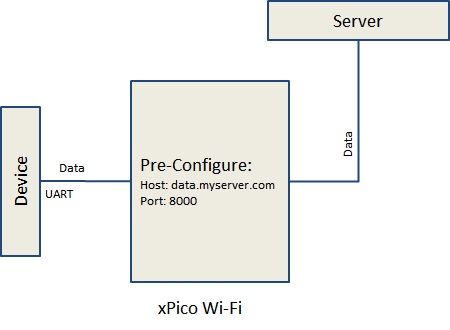Difference between revisions of "XPicoWiFi/DeveloperGuide"
(→Tunnel) |
|||
| Line 31: | Line 31: | ||
=== Tunnel === | === Tunnel === | ||
| − | [[File: | + | [[File:TunnelBlock.jpg]] |
Revision as of 19:53, 30 December 2014
Contents
Overview
Connecting xPico Wi-Fi to a microcontroller
The xPico Wi-Fi has four serial interfaces that you can use to connect to your microcontroller:
- 2 UART interfaces
- 1 SPI Master interface
- 1 USB Device full speed interface
The UART interface is the simplest to implement, as it requires no driver or special protocol.
UART interfaces
Hardware
Both UART interfaces (referred as Line 1 and Line 2) can have baud rates up to 921kbps, and only require the TX and RX pins connected to a microcontroller to work. In addition, Line 1 can also use RTS and CTS lines for hardware flow control. Both lines can use XON/XOFF software flow control.
SPI interface
The SPI interface is a Master interface, which can be controlled with the Lantronix SmartSuite Monitor application.
USB interface
The USB interface is a full speed (12 mbps) Device interface. It will be enabled in future firmware.
Serial port communication/protocol
As part of the Lantronix SmartSuite of serial port applications, the xPico Wi-Fi offers multiple applications that can run on the serial ports.
- Tunnel
- Modem Emulation (AT Commands)
- Monitor (scripting engine)
- Mux (serial API)
- Command Line Interface
You can choose a combination of these applications to run on each Line. Which application runs will depend on your microcontroller and the application.
